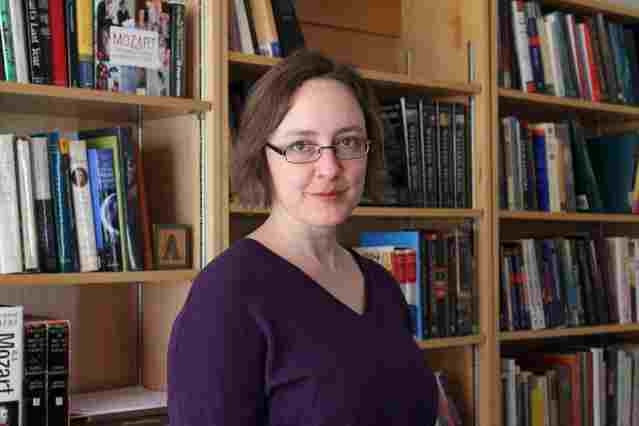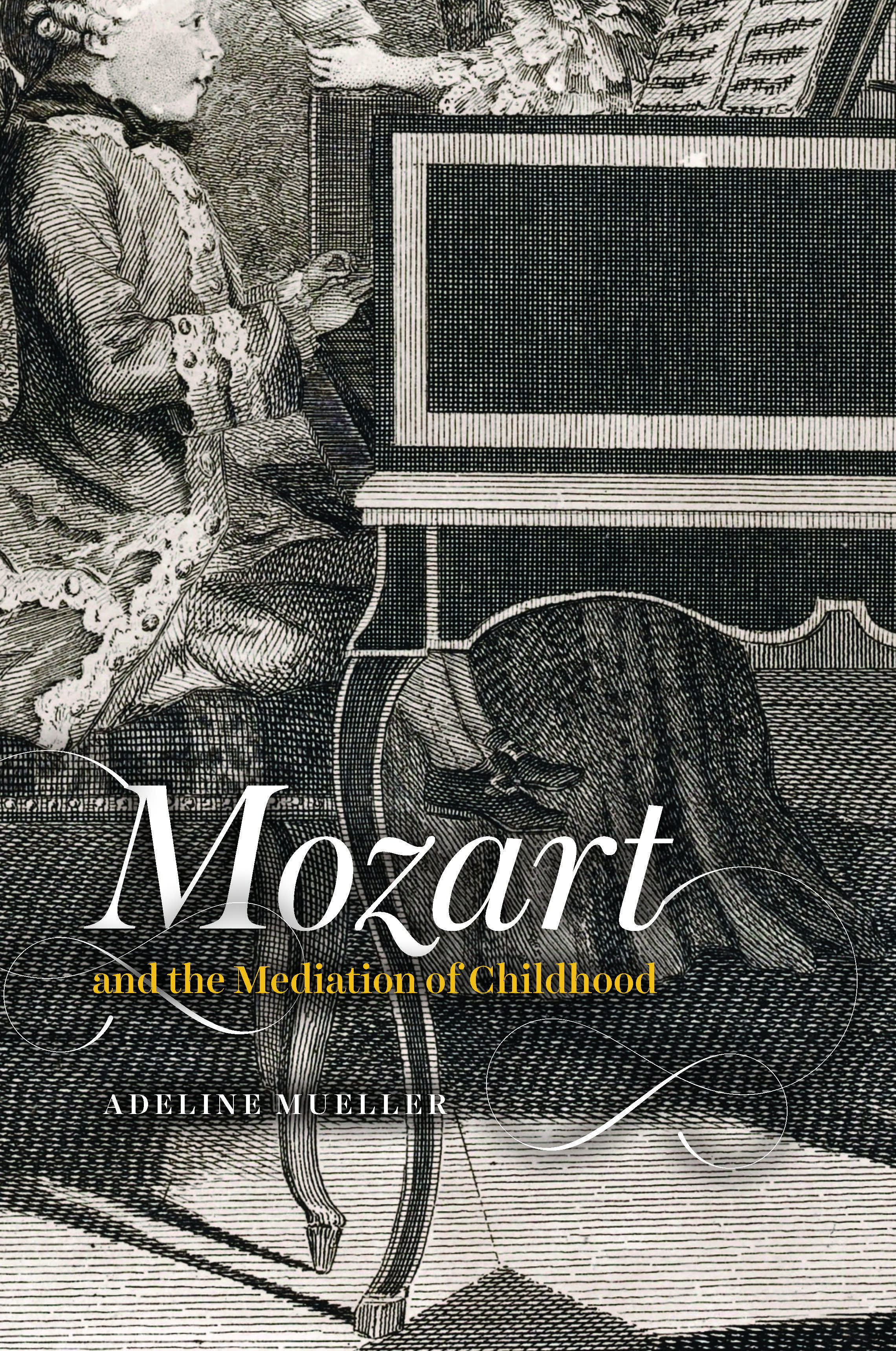Five Questions with Adeline Mueller, author of “Mozart and the Mediation of Childhood”
The composer Wolfgang Amadeus Mozart (1756–1791) is often remembered as a musical prodigy. While his precocity is taken for granted, he influenced far more than the history of classical music. In Mozart and the Mediation of Childhood, Adeline Mueller shows how Mozart’s music and persona led to a social and cultural reevaluation of childhood during the Austrian Enlightenment, transforming attitudes toward children’s agency, intellectual capacity, relationships with adults, and political and economic value. We asked Adeline a few questions about her book.
Your book argues that Mozart was a pivotal figure in the history of childhood, not just the history of music. How was childhood conceived prior to Mozart, and how did he change it?
The basic premise of my book is that the concept of childhood we’re familiar with today in the age of social media—that childhood is something that might be lived out in semi-public, particularly in the case of a child celebrity, and that archival traces of your childhood might follow you into adulthood—has its roots in the career and reception of Mozart. Before Mozart, a child in Europe might be thrust into the public eye if they were a monarch, saint, or martyr. But otherwise, even prodigies of arts and letters were generally treated as “still under construction,” or their fame was ephemeral. Once Mozart emerged as not just an extraordinary performer, but a composer, one whose compositions and likeness were sold in prints trumpeting his age (just seven years old!), that changed the terms of engagement with children as producers.
We’re all familiar with Mozart the Wunderkind, but he really was the first to perform childhood itself—like when he dressed in the uniform of the orphans at the Vienna Waisenhaus (Orphanage) while conducting them in a performance of his music for the dedication of their new church. Imagining someone holding on to their copy of an engraving of the boy Mozart until well into his adulthood really intrigued me—that freezing of childhood through print. What was it like for an adult living in 1760s Europe to purchase, study, and perform a sonata by someone who hadn’t even reached puberty when he composed it? What does it mean when a child becomes so famous that the nonsense song he used to sing with his father as a bedtime ritual becomes enshrined in his biography as his “first composition”? After Mozart and the generation of child prodigies who sought to be his successors, childhood was now something to be mediated—in the sense of conveyed or transmitted through music, and circulated via print media.
In addition to his impact on the construction of the child producer, Mozart influenced the construction of the child consumer. His lifetime overlapped with an explosion in literature for the juvenile market—children’s periodicals, plays, readers, poem and song collections, etc. The idea that children were a revenue stream for print was still new, and Mozart was right there at the beginning, publishing songs in children’s literature right and left. And the value his music helped promote—that adults should strive to be “Kinderfreunde,” friends of children, not just their parents, educators, or employers—that was an innovation particularly associated with German trends in pedagogical reform. It’s where the doctrine of Enlightenment perfectibility meets the Romantic sentimentalization of the child.
You note that Mozart was one of the first non-royal children to grow up in the public eye, in large part because his image and works were promoted and mediated via print media. What kind of documents and archives did you consult while researching this book?
I probably would not have been able to write this book as an early-career academic based primarily in the United States were it not for the extraordinary initiatives undertaken by European libraries and archives to digitize their holdings. While I compiled a number of resources in person during archival visits to Vienna, Salzburg, Berlin, and London, the majority of my findings were located online and either accessed digitally or through scan requests. For example, the 1788 children’s story “Harmony,” where a pair of angelic sisters plays a four-handed keyboard sonata by Mozart as an expression of their sisterly concord (in a rare example of what we might now call cross-promotion): I found that story thanks to a GoogleBooks keyword search.
Because so much of the project has to do with reception and public discourse, I was relying primarily on printed materials. I scoured pedagogical treatises, children’s periodicals and collections, music journals, music prints (including many pieces spuriously attributed to Mozart), and accounts of theater companies. Some of my favorite accidental finds were marginalia or hand-colored engravings in the children’s literature, presumably by young readers of the time. It reminded me that these books were not just “evidence,” but beloved family possessions, objects of use.
While you were working on this project, what did you learn that surprised you the most?
One of the things that kept surprising me throughout my research was how few degrees of separation there were between Mozart and many of the major writers, reformers, and public figures of his day, well beyond musical or theatrical figures. But probably my single favorite discovery was the fact that Mozart’s Lied “Die kleine Spinnerin” (The Little Spinner-Girl, K. 531) is tangentially related to beavers. The song first appeared in—and appears to have been composed for—a children’s periodical, and having access to the complete volume prompted me to ask a simple question: was there a connection between the surrounding text and Mozart’s Lied? I quickly found that the song about the spinner-girl came at the end of a long dialogue between a father and his two children all about the morphology, behavior, and industriousness of beavers. The editors actually “offer” Mozart’s Lied as a reward for those readers who managed to make it through the entire, sixty-page beaver lesson. Readers were meant to make these intertextual connections: between beavers’ diligence as builders, and the spinner-girl’s diligence in contributing to her family income.
What’s next for you? Are you working on any projects that you’re particularly excited about?
I gave a talk at an interdisciplinary conference, The Transmission of Songs in Birds, Humans, and Other Animals, about eighteenth-century German-language songs for family members to sing together. I’m excited that this research will soon be published in a Research Topic of the online journal Frontiers in Communication. It’s so gratifying to make connections between my work as a historian and that of ethologists, neuroscientists, evolutionary anthropologists, and psycholinguists. I’ve also been researching representations of coloniality, indigeneity, and Blackness in early German Singspiel, and as I prepare a contribution to the Cambridge Companion on The Magic Flute, I’ve learned a great deal from scholars working at the intersection of Shakespeare studies and premodern critical race theory.
My next book project is a study of Mozart’s contemporary Maria Theresia von Paradis, a blind keyboardist, composer, and music pedagogue who founded a music school for both sighted and blind girls in Vienna in the early nineteenth century. I’m interested in the technologies Paradis and her contemporaries developed for tactile alphabets and music notation, decades before Braille, and how she influenced the reform of blind education, as well as discourses of disability and music-making, across German-speaking Europe.
What is the best thing you’ve read, watched, or listened to lately?
My students often introduce me to great artists, most recently Nathalie Joachim. My go-to music for sheer pleasure is Baroque music, and some of my favorite musicians these days are harpist Marie Nishiyama, viola da gambist Lixsania Fernández, and the ensembles L’Arpeggiata and the Rose Ensemble. I always know I can count on them for adventurous programs, unexpected composers, and performances that breathe. Holing up with my family at home during the pandemic, good television has been a much-needed escape for all of us. I’m a sci-fi fan, so I’ve been enjoying The Expanse, Star Trek: Discovery, The Mandalorian, and Doctor Who. I also loved the French show Lupin and can’t wait for season 3.

Adeline Mueller is assistant professor of music at Mount Holyoke College.
Mozart and the Mediation of Childhood is available now from our website or from your local bookseller.
